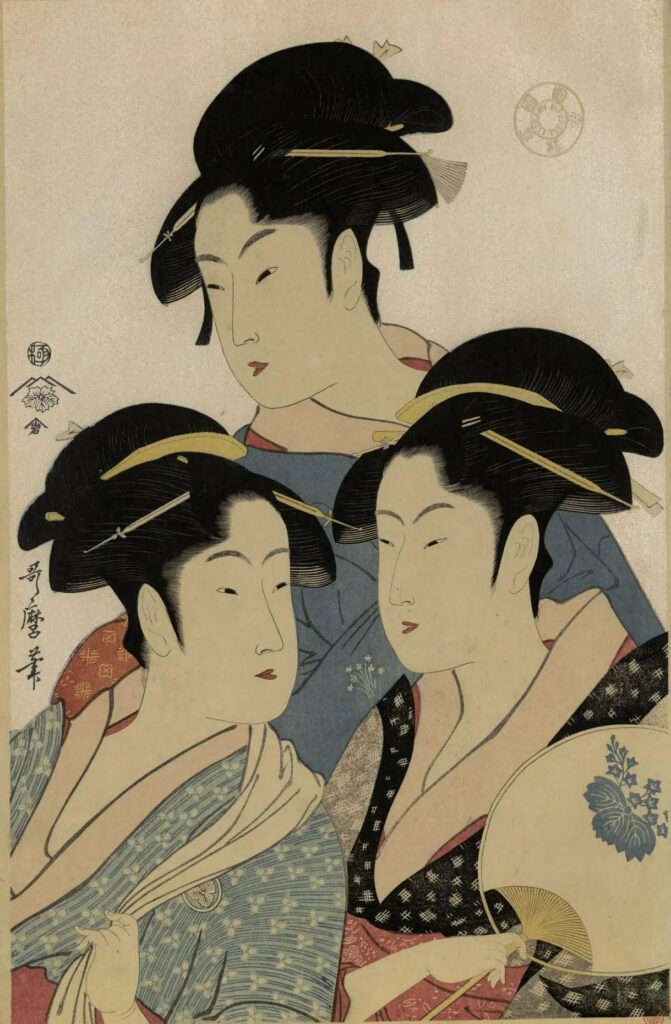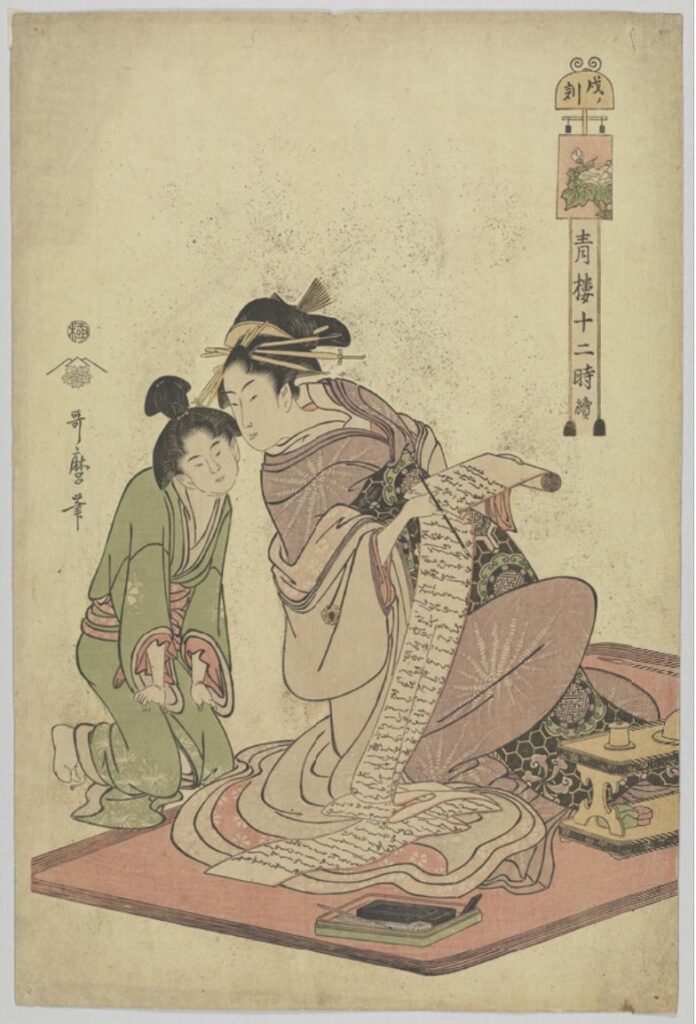The Painter of the Blue House: Kitagawa Utamaro, the man who introduced the art of portraits of beautiful women to Western artists

Kitagawa Utamaro. Utamaro, the painter of beautiful women. (Year of birth unknown-1806) A close friend of Tsutaya Juzaburo. A girl playing a popen. Kitagawa Utamaro is known as a central figure in the golden age of ukiyo-e, such as the Kansei 3 beauties. He is known for his works that delicately express not only the appearance and style of women, but also their inner selves and emotions, and he elevated painting of beautiful women to the level of art with a composition called “Ookubie”.
It is said that he left behind more than 2,600 works throughout his life, but surprisingly little information is available about Utamaro’s private life. It is certain that he died in 1812 (aged 54) and was buried at Senkoji Temple in Asakusa (Matsugaya 1-chome, Taito-ku), but there is almost no information about his birth year, childhood, relatives, etc. There is a theory that his birth year was 1866, but there is no concrete evidence, including the theory that his real name was Kitagawa Nobumi.
Utamaro studied under Toriyama Sekien of the Kano school. In his teens he went by the name Sekikazu. Among the illustrations in the New Year’s scroll “Chiyo no Haru” is an illustration of an eggplant, which is signed “Illustrated by a young boy, Sekikazu.”
After that he began calling himself Kitagawa Toyoaki. There are several surviving single-sheet nishiki-e prints of actors under the name Toyoaki, but they are extremely valuable. The oldest known painting that confirms his use of the name Utamaro is as the illustrator of the yellow-covered book “Shinpo Daitsu Shinryaku Engi.” It was not until the 1780s during the Tenmei period that Utamaro’s name was found on a single-sheet painting of a beautiful woman.
While other artists often depicted the flamboyant costumes and events of Yoshiwara, Utamaro continued to paint both the everyday life of Yoshiwara and its dark side. Furthermore, he was known as the “painter of the blue mansion” for his ability to differentiate between people through facial expressions and behavior, which was rare for the time, and for his seductive portrayals of women.
Career and style
Although details of his early years are unknown, he is thought to have been influenced by the Kano and Tosa schools. Later, he studied under Toriyama Sekien and distinguished himself while working on illustrations for kibyōshi and kyōka books. From the late Tenmei to the Kansei era (1789–1801), he produced many nishiki-e works under the patronage of publisher Tsutaya Juzaburo, and gained immense popularity among Edo townspeople. It is said that 70% of Utamaro’s works were sold by Koshodō.
Unlike the idealized images of beautiful women that had been depicted up until that point, Utamaro’s works realistically depicted real women such as Yoshiwara courtesans, town girls, and teahouse poster girls. In particular, his technique of expressing subtle expressions around the eyes and mouths and subtle emotions that are difficult to put into words sets him apart from other ukiyo-e artists of his time.
Representative works (14 points)
| Work name | overview |
|---|---|
| Selection of six famous beauties | This book depicts six highly regarded courtesans and geisha, conveying the class and elegance of these beautiful women. |
| Ten bodies of women’s studies | The idea behind this is to infer a person’s character from their facial features, and it depicts the diverse personalities of beautiful women. |
| Blue House Ninwaka Female Geisha Department | A series depicting Yoshiwara prostitutes by class, depicting cultured and artistic women. |
| The three beauties of the time | This famous composition depicts three beautiful women – a townswoman, a geisha, and a prostitute – and highlights the differences in their facial features. |
| Three Beauties of the Kansei Era | The work is based on three real women who were famous during the Kansei era. |
| Poppin’ Woman | A masterpiece that captures an everyday scene of a woman blowing a toy glass whistle. |
| Beautiful woman after bath | This work depicts a relaxing moment after a bath, combining sexiness and a sense of cleanliness. |
| Poetry Love Club | This series has a theme of love and waka poetry, and features beautiful women with rich emotions. |
| Hyakuchidori Kyokaai | It combines kyoka poetry, beautiful women, and birds. It has been re-evaluated in Germany, and Kurt’s version is also famous. |
| A Parent’s Guide to Lessons | It is a moralistic work depicting a beautiful woman and child, and its themes are motherhood and education. |
| Ehonmushi Selection | A unique book that combines insects and women, combining humor and natural observation. |
| Abalone Catching | This work depicts a female diver gathering shells, expressing one aspect of the female physical beauty and labor. |
| Seiro Picture Book Annual Event | A woodblock print illustrating the annual events held in the red-light district. It is also a valuable record of Yoshiwara culture. |
| Snow Moon Flowers | Gorgeous! A huge hand-painted painting over 5m wide. A poetic series depicting female figures against the backdrop of seasonal scenes of snow, the moon, and flowers. |

Later years and regulations
In 1804, Utamaro was punished by being handcuffed for 50 days by the shogunate for violating the “sumptuary law” by painting a historical painting, “Toyotomi Hideyoshi and Yodo-dono.” After this incident, his creative motivation waned, and he passed away in 1806. He is estimated to have been in his mid-50s.
Influence on future generations
Utamaro’s works were introduced to the West in the 19th century and led the Japonism movement. It all started with the German art critic Kurt’s Die Momochidori des Kitagawa Utamaro. Kurt introduced Sharaku, Harunobu, and others to the West, focusing on Utamaro. Kurt’s criticism had a profound impact on impressionist painters such as Monet, Degas, and Van Gogh, and he became known for the characteristics of Japanese art that expresses emotions through “lines” and “surfaces.” It can be said that the “Japonesque boom” began with Utamaro, who was introduced by Kurt.
Utamaro’s female figures go beyond simple expressions of beauty, embodying emotions, ways of life, seasonal feeling, and the poetry of everyday life, and are masterpieces that remain in the history of Japanese art.
